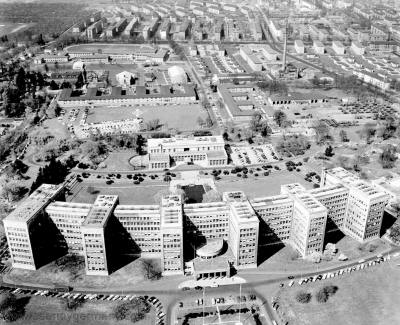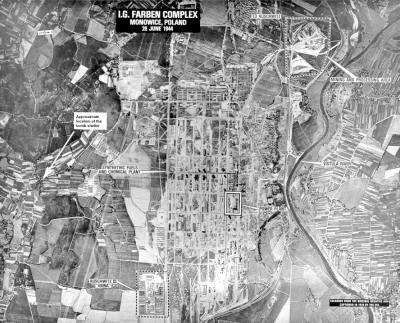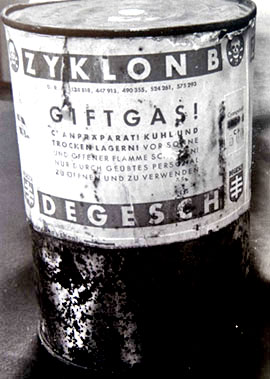|

from
Wikipedia Website
IG Farben (short for Interessen-Gemeinschaft
Farbenindustrie AG) ("syndicate of dyestuff corporations")
(and also called I.G. Farbenfabriken) was a German
conglomerate of companies formed in 1925 and even earlier during
World War I.
Farben is German for "paints",
"dyes", or "colors", and initially many of these companies produced
dyes, but soon began to embrace more advanced chemistry.
The founding of IG Farben was a
reaction to Germany's defeat in World War I. IG Farben held a near
total monopoly on chemical production, later during the National
Socialist (Nazi) regime, including manufacturing Zyklon B poison
for the gas chambers. Before the war the dyestuff companies had
a near monopoly in the world market which they lost during the
conflict. One solution for regaining this position was a large
merger.
IG Farben consisted of the following major companies and several
smaller ones.
-
AGFA (Actien-Gesellschaft für
Anilin-Fabrikation), Berlin
-
Cassella, Frankfurt
-
BASF (Badische Anilin und Soda
Fabrik), Ludwigshafen
-
Bayer, Leverkusen
-
Farbwerke Hoechst (now
Sanofi-Aventis), Höchst
-
Chemische Werke Hüls, Marl
(founded in 1938)
-
Chemische Fabrik Kalle, Biebrich
The IG Farben Building, headquarters for
the conglomerate in Frankfurt am Main, Germany, was completed in
1931.

I.G. Farben Building,
Frankfurt a.M., 1959 or 1960
Frankfurt Military Post
Collaboration with
the Nazis
During the planning of the invasion of Czechoslovakia and
Poland, IG Farben cooperated closely with Nazi officials and
directed which chemical plants should be secured and delivered to IG
Farben.
In 1941, an investigation exposed a "marriage" between United
States-based Standard Oil Co. and I.G. Farben. It also
brought new evidence concerning complex price and marketing
agreements between duPont, a major investor in and producer
of leaded gasoline, U.S. Industrial Alcohol Co. and their
subsidiary, Cuba Distilling Co.
The investigation was eventually
dropped, like dozens of others in many different kinds of
industries, due to the need to enlist industry support in the war
effort. However, the top directors of many oil companies agreed to
resign and oil industry stocks in molasses companies were sold off
as part of a compromise worked out.
IG Farben built a factory for producing synthetic oil and
rubber (from coal) in Auschwitz, which was the beginning of
SS activity and camps in this location during the Holocaust. At its
peak in 1944, this factory made use of 83,000 forced laborers.

The pesticide Zyklon B, for which
IG Farben held the patent, was manufactured by Degesch (Deutsche
Gesellschaft für Schädlingsbekämpfung), which IG Farben had 42.2
percent (in shares) of and which had IG managers in its Managing
Committee.
Of the 24 directors of IG Farben indicted in the so-called IG
Farben Trial (1947-1948) before a U.S. military tribunal at the
subsequent Nuremberg Trials, 13 were sentenced to prison terms
between 1½ and eight years.
Break-up and
Liquidation
Due to the severity of the war crimes committed by IG
Farben during World War II, the company was considered to be too
corrupt to be allowed to continue to exist, and the allies
considered confiscating all of its assets and putting it out of
business. Instead, in 1951, the company was split up into the
original constituent companies.
The four largest quickly bought the
smaller ones, and today only Agfa, BASF, and Bayer
remain, while Hoechst merged with the French Rhône-Poulenc
Rorer to form Aventis, now based in Strasbourg, France.
After the Holocaust, I.G. Farben joined with Americans to develop
chemical warfare agents. Together they founded the "Chemagrow
Corporation" in Kansas City, Missouri. The Chemagrow
Corporation employed German and American specialists for the
U.S. Army Chemical Corps. Dr. Otto Bayer was I.G. Farben's
research director. He developed and tested chemical warfare agents
with Dr. Gerhard Schrader.
Even though the company was officially liquidated in 1952, it
continued to be traded on the Frankfurt Stock Exchange as a trust,
holding a few real estate assets until it was finally declared
bankrupt on November 10, 2003 by its liquidators, after contributing
500,000 DM (£ 160,000 or € 255,646) towards a foundation for former
captive laborers under the Nazi regime and the remaining property,
worth DM 21 million (£ 6.7 million or € 10.7 million) going to a
buyer.
During this lengthy period, the holding
company had been continually criticized for failing to pay any
compensation to the former laborers, which was the stated reason for
its continued existence after 1952. The company, in turn, blamed the
ongoing legal disputes with the former captive laborers as being the
reason it could not be legally dissolved and the remaining assets
distributed as reparations. Each year, the company's annual meeting
in Frankfurt was the site of demonstrations by hundreds of
protesters.
Holocaust
Memorial controversy
In 2003 Degussa, a company closely associated with IG
Farben during the Nazi period, was involved in a major
controversy surrounding its involvement in the construction of the
Memorial to the Murdered Jews of Europe ("Holocaust
Memorial") in Berlin. Degussa produced the anti-graffiti substance
Protectosil used to cover the stelae which are the major
element in the memorial.

The dispute arose mainly because
Degussa had also owned 42.2 percent of the shares in Degesch,
at the time when that company was producing Zyklon B. The
board of trustees of the memorial ultimately decided that, given the
cost of eliminating Degussa's role in the project at that relatively
late stage, the use of Protectosil ought to continue, despite
protests from many Jewish groups.
|



